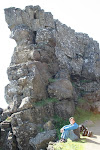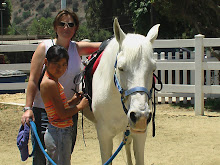August 12, 2009
Equine Clicker Training with Pat Lincourt: part two
On a recent weekday afternoon at The Paddock Riding Club, Pat Lincourt was kind enough to allow me to observe a brief clicker training session with one of her client's horses. Jake is a talented jumper from New Zealand. This large, athletic horse has been injured and unable to work; he's cooped up in his stall day after day, with a lot of pent-up energy. Even at his best, Jake has a tendency to bolt when turned out for exercise. Imagine the intensity and power that will be unleashed after weeks of layup in his stall.
Bolting is a common and scary issue for many horse owners. As the horse is being walked to the turnout paddock, it anticipates being allowed to run free, gets worked up just as the paddock gate is being opened, and starts to pull. The horse might take off before the handler can safely remove the halter, close the gate and get out of the way. It's a potential disaster in the making because the risk of injury to horse and handler increases over time. Jake's bolting needed to be corrected.
Patricia decided to try adding clicker training to Jake’s usual routine. She hoped that the mental stimulation of clicker training would help to keep the horse occupied, use up some of his excess energy, and allow him to focus on her instead of bolting when he is taken to his turnout paddock. Pat enters Jake’s stall and shows him the target pole. She has a treat pouch around her waist, but doesn’t put a treat in her hand just yet. Pat says “target” and waits for Jake to figure out that he is supposed to touch his nose to the end of the pole. If he does, she clicks, instantly – timing is crucial to mark the correct or wanted behavior – and then takes a treat out and offers it to Jake. Over time, Pat moves the target farther away from Jake, little by little, until he has to come to her in order to touch the pole.
Eventually, when the horse is successful most of the time, Pat moves the target pole to another location in the stall, and stands in a corner. When she says “target" this time, Jake will have to go over to the target pole, touch it, and then walk back over to where Pat is standing in order to get his treat. Progess takes place very slowly, and consistency is key. Clicker training requires many repetitions, but it's vital to take the time to cement behaviors before moving on.
Building slowly towards more complex cues is very important if you want the horse to learn and remember. Now, after a few weeks of training sessions, Pat can ask Jake to do something that involves moving away from or towards her, just by clicking. This means that Jake will be responsive to Pat from a distance, even if she doesn't have a lead rope or reins in her hand. She will have the ability to communicate with and direct the horse, without having to use a halter, bit or lunge line.
With patience, the training possibilities are virtually limitless. Imagine a horse that is afraid to climb up into a trailer, or just refuses to budge, and the ordeal it becomes to load that horse. With proper clicker training, that obstinate or fearful horse can be encouraged to move forward, no matter what, towards a target, in anticipation of a food reward. This conditioning will allow the horse to “forget” that it’s afraid of trailers, to move towards the target pole when asked, even if it’s placed inside of the trailer, and then receive a treat. You start slowly, asking the horse to take just one or two steps forward. Then move on to a more complex behavior, with lots of repetition, consistency and patience.
After several clicker training sessions, the horse can be directed to stand with all four hooves placed on a mat on the ground, and then to move forward onto the mat from an increasing distance away. Eventually the mat can be put inside the trailer, and the clicker and treat reward can be repeated. The horse will forget to focus on the fear of walking up into a trailer, but will respond instead to the clicker and the promise of the treat that he'll receive, once he's standing inside the trailer, on the mat.
Under the right circumstances and with enough time and dedication, clicker training can work wonders for a variety of common issues and behavioral problems in horses. Jake has learned to calm down and focus while getting much less exercise than he’s used to, and Patricia is confident that he will learn not to bolt into his turnout paddock, now that he pays attention to her when she clicks and treats.
After only a few weeks of clicker training, Jake is responding quickly to the cues and has become much more manageable and calm. Pat has started using a clicker and target pole with other horses in her barn and is already seeing improvement. While emphasizing that clicker training is not a "magic bullet" for resolving all behaviorial problems, Pat believes that with consistent work and lots of time and patience, it can become an effective and valuable addition to any horse trainer's repertoire.
To contact Pat Lincourt and Lincourt Stables:
Website: www.LincourtStables.com
E-mail: gone2horses@gmail.com
Tel: 818.822.0881
The Paddock Riding Club: http://www.thepaddockla.net/
Bolting is a common and scary issue for many horse owners. As the horse is being walked to the turnout paddock, it anticipates being allowed to run free, gets worked up just as the paddock gate is being opened, and starts to pull. The horse might take off before the handler can safely remove the halter, close the gate and get out of the way. It's a potential disaster in the making because the risk of injury to horse and handler increases over time. Jake's bolting needed to be corrected.
Patricia decided to try adding clicker training to Jake’s usual routine. She hoped that the mental stimulation of clicker training would help to keep the horse occupied, use up some of his excess energy, and allow him to focus on her instead of bolting when he is taken to his turnout paddock. Pat enters Jake’s stall and shows him the target pole. She has a treat pouch around her waist, but doesn’t put a treat in her hand just yet. Pat says “target” and waits for Jake to figure out that he is supposed to touch his nose to the end of the pole. If he does, she clicks, instantly – timing is crucial to mark the correct or wanted behavior – and then takes a treat out and offers it to Jake. Over time, Pat moves the target farther away from Jake, little by little, until he has to come to her in order to touch the pole.
Eventually, when the horse is successful most of the time, Pat moves the target pole to another location in the stall, and stands in a corner. When she says “target" this time, Jake will have to go over to the target pole, touch it, and then walk back over to where Pat is standing in order to get his treat. Progess takes place very slowly, and consistency is key. Clicker training requires many repetitions, but it's vital to take the time to cement behaviors before moving on.
Building slowly towards more complex cues is very important if you want the horse to learn and remember. Now, after a few weeks of training sessions, Pat can ask Jake to do something that involves moving away from or towards her, just by clicking. This means that Jake will be responsive to Pat from a distance, even if she doesn't have a lead rope or reins in her hand. She will have the ability to communicate with and direct the horse, without having to use a halter, bit or lunge line.
With patience, the training possibilities are virtually limitless. Imagine a horse that is afraid to climb up into a trailer, or just refuses to budge, and the ordeal it becomes to load that horse. With proper clicker training, that obstinate or fearful horse can be encouraged to move forward, no matter what, towards a target, in anticipation of a food reward. This conditioning will allow the horse to “forget” that it’s afraid of trailers, to move towards the target pole when asked, even if it’s placed inside of the trailer, and then receive a treat. You start slowly, asking the horse to take just one or two steps forward. Then move on to a more complex behavior, with lots of repetition, consistency and patience.
After several clicker training sessions, the horse can be directed to stand with all four hooves placed on a mat on the ground, and then to move forward onto the mat from an increasing distance away. Eventually the mat can be put inside the trailer, and the clicker and treat reward can be repeated. The horse will forget to focus on the fear of walking up into a trailer, but will respond instead to the clicker and the promise of the treat that he'll receive, once he's standing inside the trailer, on the mat.
Under the right circumstances and with enough time and dedication, clicker training can work wonders for a variety of common issues and behavioral problems in horses. Jake has learned to calm down and focus while getting much less exercise than he’s used to, and Patricia is confident that he will learn not to bolt into his turnout paddock, now that he pays attention to her when she clicks and treats.
After only a few weeks of clicker training, Jake is responding quickly to the cues and has become much more manageable and calm. Pat has started using a clicker and target pole with other horses in her barn and is already seeing improvement. While emphasizing that clicker training is not a "magic bullet" for resolving all behaviorial problems, Pat believes that with consistent work and lots of time and patience, it can become an effective and valuable addition to any horse trainer's repertoire.
To contact Pat Lincourt and Lincourt Stables:
Website: www.LincourtStables.com
E-mail: gone2horses@gmail.com
Tel: 818.822.0881
The Paddock Riding Club: http://www.thepaddockla.net/
Subscribe to:
Post Comments (Atom)
.jpg)







No comments:
Post a Comment